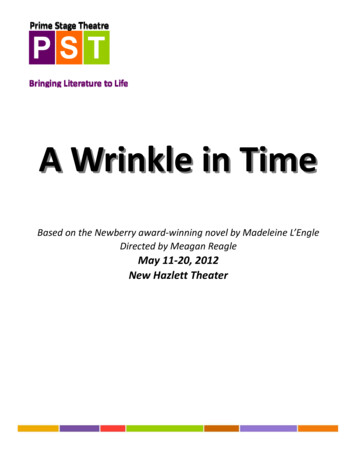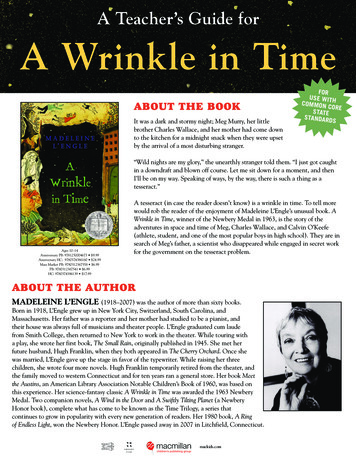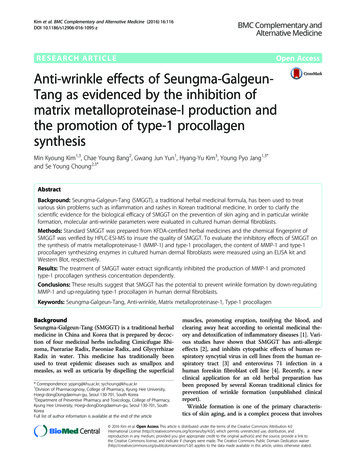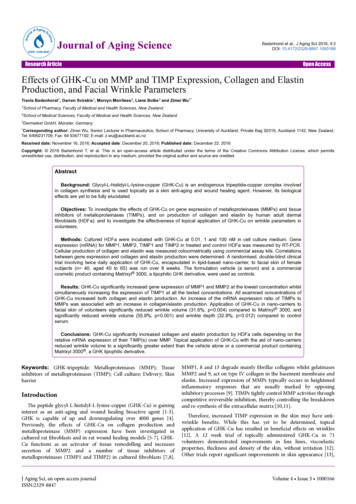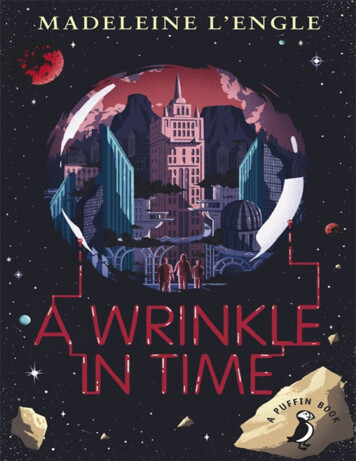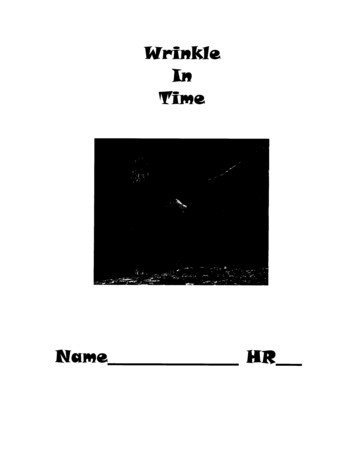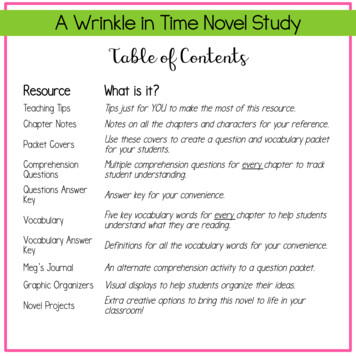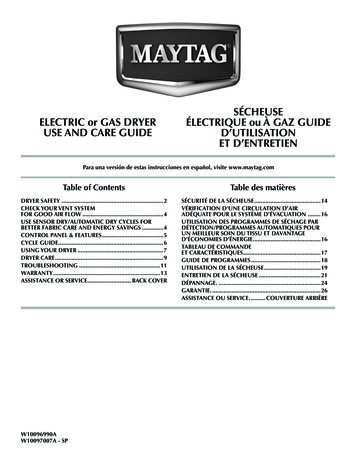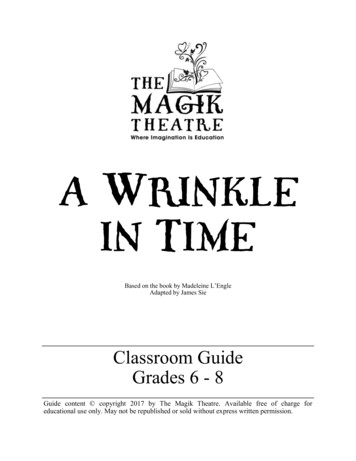
Transcription
a Wrinklein TimeBased on the book by Madeleine L’EngleAdapted by James SieClassroom GuideGrades 6 - 8Guide content copyright 2017 by The Magik Theatre. Available free of charge foreducational use only. May not be republished or sold without express written permission.
How to Use This GuideThis classroom guide for A Wrinkle in Time is designed for Texas students inGrades 6, 7 and 8. It offers activities to help you integrate a performance of AWrinkle in Time into English language arts (ELA), mathematics, science, socialstudies, music, art, and theatre curricula.All activities in this guide are linked to Texas Essential Knowledge and Skills(TEKS) content standards.For students outside Texas, this guide’s ELA and math activities also are linked toCommon Core standards. At the back of this guide, you will find a list of theguide activities and their related Texas and Common Core standards.Table of ContentsTheatre1: Discussion Questions . . . . . . . . . . . . . . . . . . . . . . . . . . . . . . . . . . . . . . . . . . . . . . . . . . . . . . . . 3English Language Arts2: Magik Must Reads . . . . . . . . . . . . . . . . . . . . . . . . . . . . . . . . . . . . . . . . . . . . . . . . . . . . . . . . . 43: World Building . . . . . . . . . . . . . . . . . . . . . . . . . . . . . . . . . . . . . . . . . . . . . . . . . . . . . . . . . . . . 5Mathematics4: Look At Them Go! . . . . . . . . . . . . . . . . . . . . . . . . . . . . . . . . . . . . . . . . . . . . . . . . . . . . . . . . . 6Science5: Make a Tesseract . . . . . . . . . . . . . . . . . . . . . . . . . . . . . . . . . . . . . . . . . . . . . . . . . . . . . . . . . . . 7Social Studies6: Stars of Outer Space . . . . . . . . . . . . . . . . . . . . . . . . . . . . . . . . . . . . . . . . . . . . . . . . . . . . . . . . 8Art7: Create Your Own Galaxy . . . . . . . . . . . . . . . . . . . . . . . . . . . . . . . . . . . . . . . . . . . . . . . . . . . . 9Music8: If the Universe Could Sing . . . . . . . . . . . . . . . . . . . . . . . . . . . . . . . . . . . . . . . . . . . . . . . . . . 10AppendixActivity Content Standards . . . . . . . . . . . . . . . . . . . . . . . . . . . . . . . . . . . . . . . . . . . . . . . . . . . . 112
Grades 6 – 8THEATRE1: Discussion QuestionsBefore the PerformanceA Wrinkle in Time is a stage play. What is a stage play? How is a play similar to a TV show or movie? How is it different?Who performs the parts (roles) in a play? What kinds of skills do you think performers need to have to perform in plays? Who else works on plays? (Remember: you may not see them on stage!)The play is based on a story called A Wrinkle in Time. Have you read A Wrinkle in Time as a class or by yourself? Based on what you read, what do you think may happen in the play?During the PerformanceWhen you watch a play, you are a member of the audience. What kinds of things should you doas an audience member? Examples: Pay attention Laugh when something funny happens Clap if you enjoy somethingWhat kinds of things should you not do as an audience member? Examples: Talk to your neighbor Use a cell phone during the performance Yell at the actors (unless they ask you to!)After the PerformanceWhat did you think of the play? If you read A Wrinkle in Time beforehand, how was the play similar to the book? How was it different?Describe the performers in the play. What did they do to make their characters special (different from the other characters)? How did they use their bodies to play their characters (using voice, movement, etc.)? Did you see anyone else who worked on the play besides the performers on stage?Describe the characters’ costumes. What did each character’s costume tell you about that character? Did any of the performers change costumes? If so, why do you think they needed to change costumes?Describe the set of the play. Did it have a lot of locations? Did it look like a place you’ve been to before? How did different lighting change how the set looked for different scenes?Did the play have music in it? If so, was it only in the background, or did it help tell the story? What instruments did you hear in the music?If you were going to direct A Wrinkle in Time how would your production be different than theplay you saw by Magik?3
Grades 6 – 8ENGLISH LANGUAGE ARTS2: Magik Must-ReadsFor each of our main stage productions at The Magik Theatre, we choose a theme related to theshow. Then we create a list of Magik Must-Reads on that theme.The reading theme for A Wrinkle in Time is Good vs. Evil.The Magik Must-Reads (Grade 6 - Grade 8) are:The Lightning Thief by Rick RiordanCity of Bones by Cassandra ClareTreasure Island by Robert Louis StevensonThe Hunger Games by Suzanne CollinsPlease note: These books may contain mature themes.Read them as a class or let students choose two or more to read. Then use these questions fordiscussion or book reports:ThemeHow did the theme of Good vs. Evil show in each book? Explain.SettingDescribe the settings of each book. What details can you remember? Were the settings similar to a place you know or a place you’ve visited?How were the settings similar to each other? How were they different?How were the settings related to the theme of Good vs. Evil? Explain.CharactersWho were the main characters of each book?Did any characters show up in more than one book?Were the characters of one book similar another book’s characters in any other ways?PlotWhat did the main characters of the books want most?Did anyone or anything stand between the main characters and their goals?Did the main characters get what they wanted? How?How were the plots of the books similar? How were they different?4
Grades 6 – 8ENGLISH LANGUAGE ARTS3: World BuildingWhen creating a story based in fantasy and/or science fiction, writers often have to build theirown worlds, or create their own version of our world. Observe and analyze the structure ofCamazotz. Consider how Camazotz came to be. Who lives there? What is the culture ofCamazotz? Using the details and skills you’ve observed create your own world. When you havefinished creating your world, include it in a short story! Answer the questions below as youcreate your world:Is your world a planet, and island, is it our world, but your own version of it?What’s the climate like?What’s the name of your world? Does this name have any special meaning? Why was thisname chosen?Who lives there? What is the culture like? Are there laws? What type of government exist inthis world?What is the history of your world?TITLE:5
Grades 6 – 8MATH4: Look At Them Go!When tesseracting our heroes travel fast. To measure the speed of an object or personmathematicians and physicists use the formula v d/t . The little v is the symbol for velocity,how fast something or someone is going. Little d is the symbol for distance, how far someone orsomething has traveled. Little t is the symbol for time, the duration of second or hours, it takessomething or someone to travel. The / is the symbol indicating you should divide theinformation given. Answers to this equation are often written as X m/s, where X represents theanswer, m is how many miles are traveled, and s is one second. s could be replaced with otherunits of time, while m could be replaced with other ways of measuring distance! Use theformula and information above to find the answers to the following questions.1) Meg tesseracts at a distance of 25 miles in 5 seconds. What is the velocity of hertesseracting?2) Calvin is attempting to tesseract. He doesn’t get very far as he only travels 4 miles withintwo seconds. What is Calvin’s velocity?3) With Meg’s help Charles Wallace is able to tesseract 20 miles away from home within 5seconds. What velocity are Meg and Charles Wallace tesseracting at?4) Calvin tesseracts at a distance of 50 miles in 10 seconds. Meg tessaracts at a distance of 100miles in 20 seconds. Who is going faster?5) If Meg’s velocity is 150 m/s, and she is traveling for 30 seconds, how many miles has shetraveled?6
Grades 6 – 8SCIENCE5: Make a TesseractTo travel across space and time several characters use a skill called tesseracting. It is a trickdone by jumping from one dimension to another. Seeing dimensions other than our own isdifficult, but we can get fairly close. Follow the instructions below to build your own diagramof a tesseract.Materials Hot glue gun 12 cotton swabs A bowl Dish soap Scissors (optional)Procedure1) Create a hypothesis. What do you think is going to happen when the soap interacts with thecotton swabs?2) Fill the bowl with soap and set it aside.3) Take the cotton of the ends of the cotton swabs. You can either pull off the cotton or cutthem off with a pair of scissors, however keep in mind that if you cut the cotton off theends, your tesseracts will be smaller.4) Make two squares with the cotton swabs.5) With the remaining cotton swabs connect the two squares using the hot glue gun - makesure to have the help or permission of your teacher. Let the glue dry when done. You shouldhave made a cube.6) Gently take your cube and dip it into the bowl of soap. When you take out the cube the soapshould create a square bubble in the center representing the fourth dimension.7) Having fun observing the tesseract and don’t forget to clean up!Follow-Up Questions1) What happened when you dipped the cube in the soap?2) Did you see any colors or were things just clear?3) If you saw colors in the cube, do you know why that was?4) As a class, discuss!7
Grades 6 – 8SOCIAL STUDIES6: Stars of Outer SpaceHumans have been interested in spaces for centuries, but it’s only recently that we’ve traveledthere. We have always speculated about it and studied it, with many making history while doingso, but the first person to go to space went in 1961! Write a report on one person who madehistory because of their space contributions. You can use whichever figure you find the mostinteresting. Who were they? What did they do? When you’ve finished your report, present it tothe class!Directions1) Using books from the library orinformation on the internet,research several key figures whohave in some way made spacehistory. You can look forastronauts, astronomers,astrophysicists, physicists,computer scientists,mathematicians, writers,philosophers, artists, etc.2) After gather interesting factsabout the person of your choice,write a report about them andpresent your report to your class.Follow-Up Questions1) Out of all the space figurespresented, who caught yourinterest? What was it that theydid?2) What were some of theprofessions of the chosenfigures? Were they all Americanor did you have figures fromaround the world?3) Did any of your classmateschoose figures that worked witheach other? If so, who? When?8
Grades 6 – 8ART7: Create Your Own GalaxyDuring the play Meg, Calvin, and Charles Wallace travel across the universe, visiting differentplanets and galaxies. Our universe is infinite and there’s so much astronomers andastrophysicists have yet to explore! Planets across the universe could have life and we don’teven know it yet. The possibilities are endless, so why not create your own galaxy?Materials Watercolors Paintbrush(es) Star stickers (optional) Salt Water Cup(s) Spray bottle (optional) Watercolor paper (cardstock canbe used as a substitute)Instructions1) Gather your supplies. Fill two cups with water. One will be to clean your brushes and theother will be used to wet your brushes. If you have a spray bottle fill it with water as well.2) Get your paper and using the spray bottle or a wet paint brush layer the paper with a coat ofwater to let the watercolors flow about the paper.3) Now you can begin painting with any color(s) you’d like. It’s your galaxy! Have funpicking and mixing colors! Don’t forget to clean your brush when switching colors.4) When you’re done painting pour a small amount of salt in the palm of your hand. Sprinklethe salt around your galaxy, and let it dry.5) Once the paint is dry shake off excess salt and decorate your galaxy with star stickers orpaint your own stars!6) Have fun gazing at your super stellar galaxy! (Don’t forget to clean up.)9
Grades 6 – 8MUSIC8: If the Universe Could SingThe universe is a cold noiseless vacuum. Sound can’t be heard in space, however astronomershave been able to record frequencies of different objects in space. Using these frequenciesastronomers have been able to get an idea of what objects across the universe might sound like.Using your creativity and imagination, use an instrument (anything that be used to make sound)to compose a short song that represents what you think the universe would sound like.While composing, consider the following.1) When you think of space what do you feel?2) How would you describe the emotions you feel?3) How could these emotions translate into music?4) What are some sounds that you think might be heard in space?5) How loud or quiet would the universe be if it could sing?6) Does your song have lyrics or is it just instrumental? If you think it has lyrics, write thembelow.Follow-Up Questions1) What instrument did you choose you use while composing? Why did you choose it?2) Did you choose to use words? Why or why not?3) Was your song quiet or loud? Why did you make that choice? (What about space made youthink the song should be quiet/loud?)10
APPENDIXACTIVITY CONTENT STANDARDSTEXASGrade 6Activity12345678Grade 7Activity12345678Grade 8Activity12345678Standard(s)Fine Arts 117.211.b.5ELA 110.18.b.3ELA 110.18.b.14Math 111.26.b.1.A; 111.26.b.3Science 112.18.b.1Soc Studies 113.18.b.20.A;113.18.b.21. A; 113.18.b.22Fine Arts 117.202.c.1-2, 4Fine Arts 117.208.c. 3-4Standard(s)Fine Arts 117.212.b.5ELA 110.19.b.3ELA 110.19.b.14Math 111.27.b.1.A; 111.27.b.3Science 112.19.b.1Soc Studies 113.19.b.20.C;113.19.b.21.A; 113.19.b.22Fine Arts 117.203.b.1-2, 4Fine Arts 117.209.c.3-4COMMON COREGrade 6ActivityStandard(s)2ELA 6.L.KI&D.23ELA 6.W.P&DW.45Math 6.NS.2Grade 7Activity235Standard(s)ELA 7.L.KI&D.2ELA 7.W.P&DW.4Math 7.NS.2Grade 8Activity235Standard(s)ELA L.8.KI&D.2ELA 8.W.P&DW.4Math 8.EE.7Standard(s)Fine Arts 117.213.b.5ELA 110.20.b.3ELA 110.20.b.14Math 111.28.b.1.AScience 112.20.b.1Soc Studies 113.20.b.28.A;113.20.b.29.A; 113.20.b.30Fine Arts 117.204.b.1-2, 4Fine Arts 117.210.c.3-411
This classroom guide for A Wrinkle in Time is designed for Texas students in Grades 6, 7 and 8. It offers activities to help you integrate a performance of A Wrinkle in Time into English language arts (ELA), mathematics, science, social studies, music, art, and theatre curricula.

